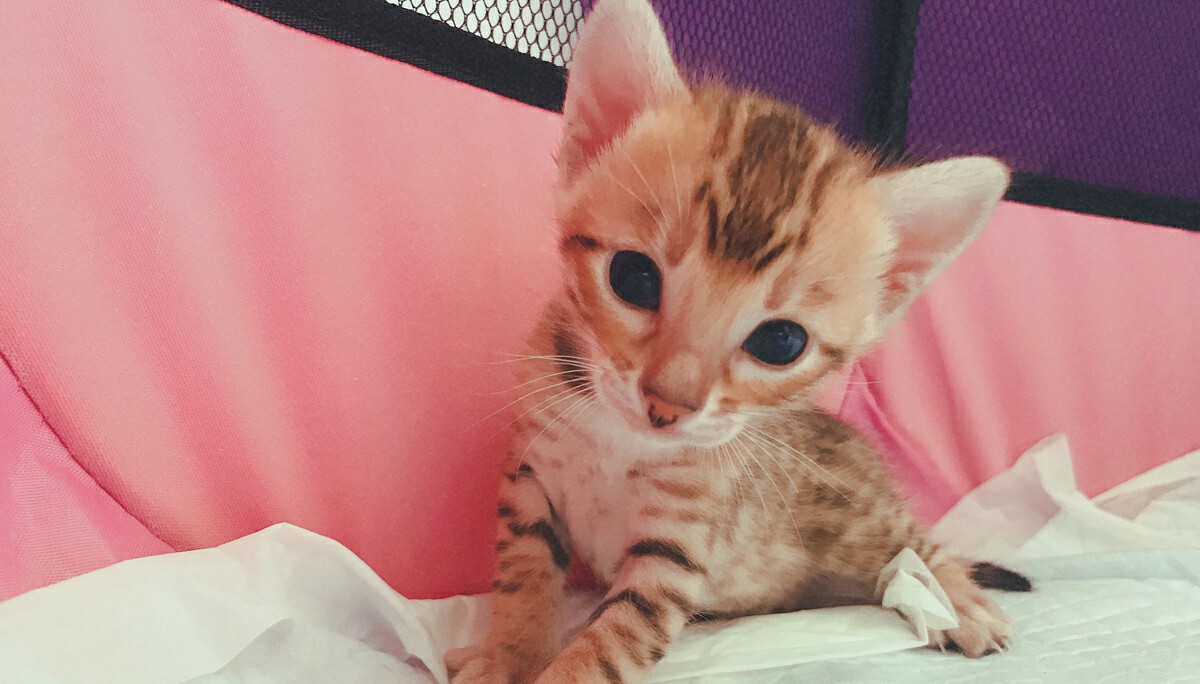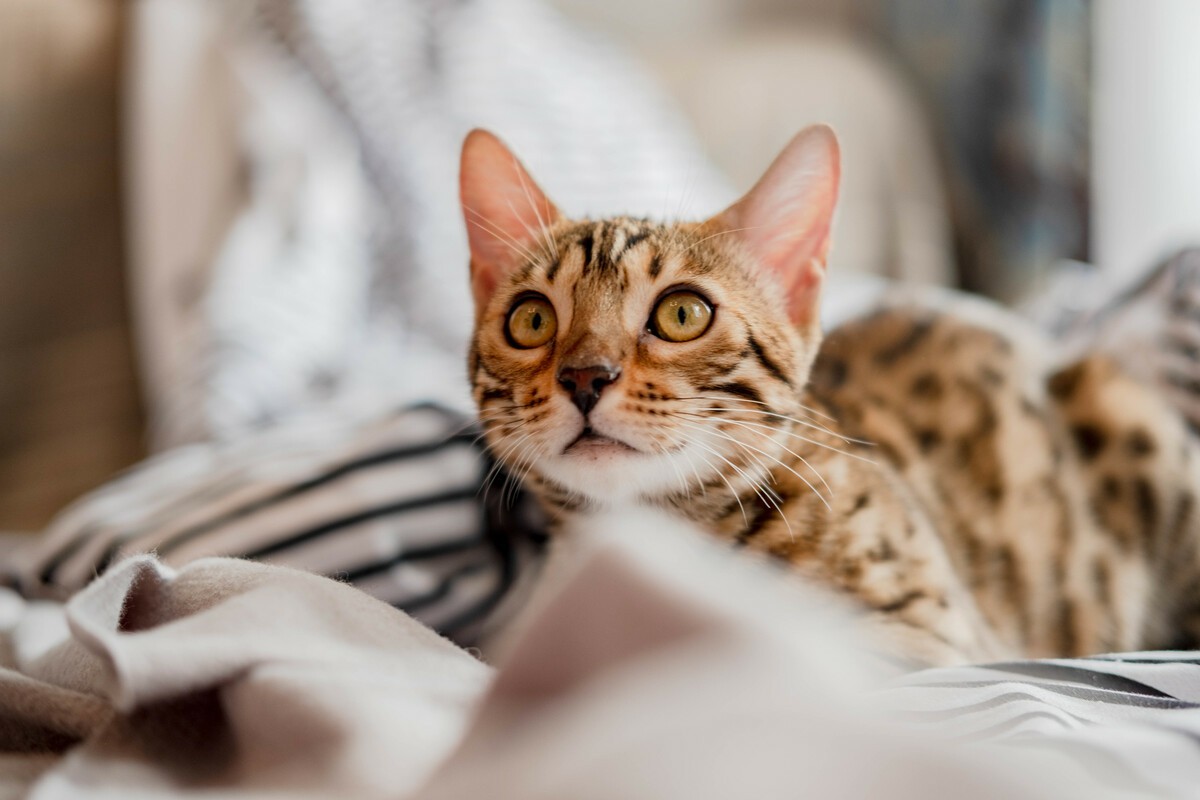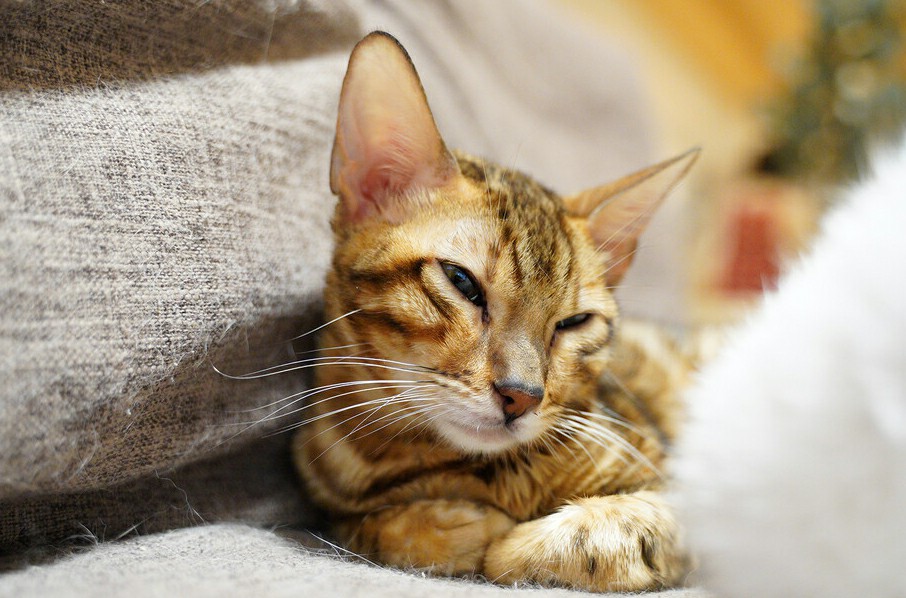Bathing cats – definitely not on the top of my “what I love about owning a feline” list. If you’ve ever had the pleasure of bathing one of these creatures, chances are you’ve come out of the whole ordeal more terrified than them.
Bathing Bengal cats requires patience but not as much as what you’ll need when bathing other cat breeds. While other breeds avoid water as if they were made of sugar, Bengal cats actually have quite a keen interest. Most Bengal cats dislike being soaking wet but do enjoy playing with it and getting their paws a little damp.
That being said, it’s not uncommon to come across a Bengal who enjoys taking baths. I know I have found my Bengal screaming outside the shower in hopes I’d let him in.
So, in this article, we’re going to give you the lowdown on everything you need to know about bathing your Bengal kitty. Plus, we’ll give you some additional tips and tricks on grooming.
Do Bengal cats like baths?
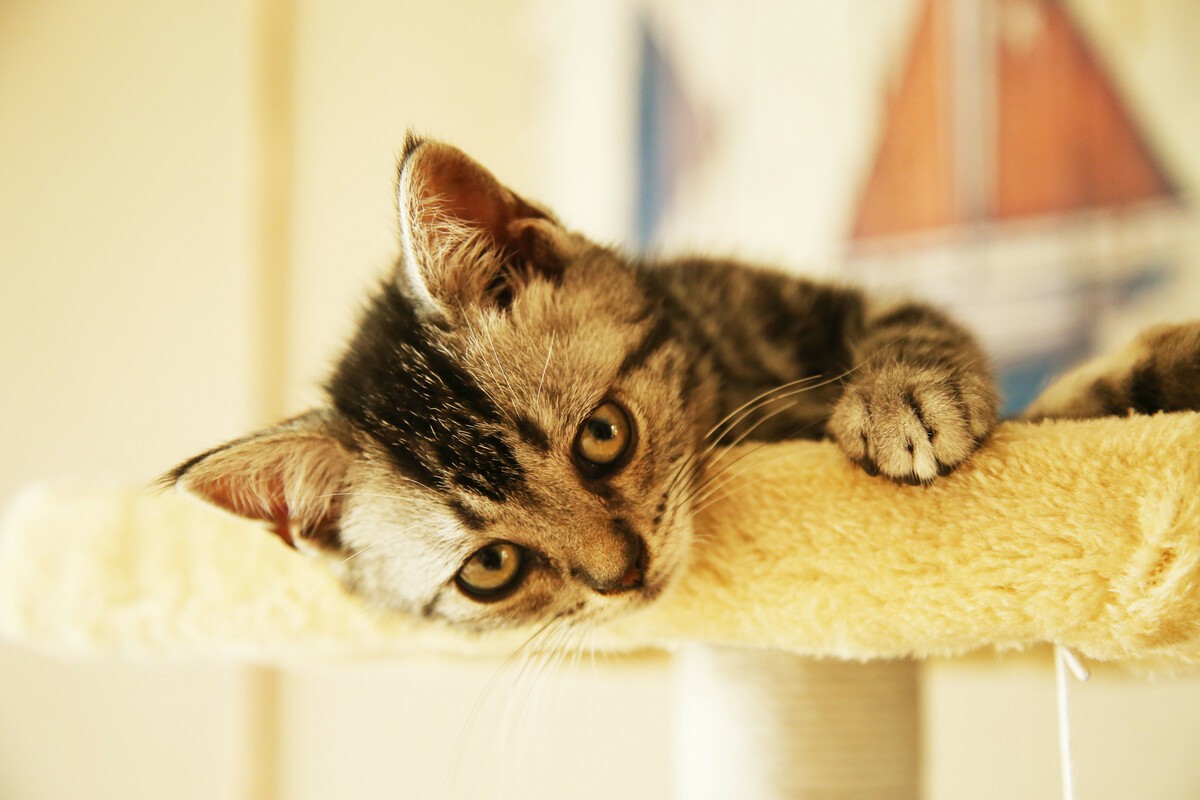
All cats detest baths, right?
You’d be surprised! Bengal cats are among the few breeds who actually enjoy the water. While they may not be too pleased with having a full-blown bath, it should be less of a hassle than bathing your average moggie.
Since cats are natural groomers, you won’t need to bathe them often. However, sometimes cats get themselves into sticky situations and bathing becomes inevitable.
You may have already found your Bengal hanging around the bathroom on numerous occasions. This is for a few reasons:
- They love feeling the smooth and cool sensation on their paw pads.
- They enjoy the sound water makes and the reflective surface.
- Their natural instincts lead them to running water as opposed to stagnant.
While other cats may be terrified of a tub full of water, Bengal cats will usually sit on the side and watch their humans bathe. They may even dip a paw in here and there.
Of course, not all Bengal cats will enjoy the water, it just depends on their personal preference.
How often should I bathe my Bengal?
How often you need to bathe your Bengal depends on their certain type. Some Bengal kitties have short hair while some have long hair.
For Bengal cats with short hair, you’ll only need to bathe them every 2-3 months. For long-haired Bengals, it will be around 1-1.5 months.
This also depends on how well your Bengal cleans themselves. Ones that are very throughout will need to be bathed less compared to ones that are a little lazy.
If you over-bathe your Bengal, their skin will become dry and their fur will become damaged. However if you let them go dirty, not only will they be smelly, but their fur will become a breeding ground for bacteria.
Here are some other factors that determine how often your Bengal needs bathing:
1.How often your Bengal goes outside
Most Bengal kitties are indoor cats, as are mine. They require special care and are all around not very streetwise.
However, many owners set up secure play areas outdoors to help fulfill their love for the wild. Bengal cats are also quite clever, so many people have trained them to walk on a lead.
If you’re one of these owners, you’ll want to bathe your Bengal more often since they are more likely to get dirty. This could be every 1 month, or when they start to look a little dirty.
If you decide to go hiking or take your Bengals in the woods, it’s a good idea to give them a bath or a light wash when you get home. Long grass is especially home to pests that cling to your Bengal’s fur.
2.The age of your Bengal
Kittens are messy little fellows. I remember having a kitten that would not stop getting into messy situations, whether that be getting food and milk all over his face, somehow getting into my plant-pots, or using his litter tray like a sandbox.
Since kittens get a lot dirtier than adult cats, you may have to give them a little wash every 4-6 weeks. You should only bathe them when they are big enough.
Senior cats may find it more difficult to groom themselves as they age. They may simply be too tired to do so. Therefore you should help them out when needed.
3.If your Bengal has ticks or fleas
Of course, if your Bengal has picked up some ticks or fleas you should always wash them according to your vets’ recommendations. You should pick up some good flea & tick shampoo and wash your Bengal with.
If your Bengal goes outdoors often, it would be good to wash them with shampoo once a month to keep the ticks away.
4.Your Bengal’s surroundings
A Bengal who lives in a dirty environment is far less likely to maintain their cleanliness than one who lives in a clean home. If there is less dust and dirt, their coat will keep cleaner for longer.
A clean, warm home will give your Bengal the motivation they need to stay clean and wash themselves regularly.
How to prepare
Before we head into battle, there are a few things we can do to prepare:
1.Protect yourself
Even if your Bengal enjoys water, chances are they won’t enjoy bath time – especially when it’s forced. To protect your limbs, you should wear a long sleeve shirt and pants.
You’re also going to get very wet, so ensure they’re clothes you don’t care too much about.
2.Cut those claws
It’s a good idea to give your Bengal’s nails a little trim before you begin. I can’t tell you how many times I’ve almost lost my eyeballs from bathtime! your Bengal will most likely try to escape the bath and use you as leverage.
If you’re lucky, your Bengal will just happily sit in the bath and let you go to work. However, it is always better to be cautious.
To keep yourself safe from those claws, you can simply buy Nail Caps for Cats. Just click the link to buy them from Amazon I asked Robyn to model them for you:
3.Brush that fur
Brushing your Bengal, whether they are long-haired or short-haired, is a step not to be missed. This will remove any knots and tangles they may have. Once these knots get wet, they will be a lot harder and painful to remove.
If your Bengal enjoys being brushed, it’s a good idea to do this in the tub or sink (before you add water) so they feel more comfortable and safe.
4.Prep the work space
While many opt to wash their cats in the bath or shower, the kitchen can actually be the perfect place, especially if you have a double sink. One half of the sink can be used for bubbles and the other half for rinsing.
Always have a towel at hand so you can wrap your Bengal up as soon as they get out. You can lay a folded towel at the edge of the sink so when bathtime is finished, your Bengal can climb straight out and into the towel.
Another handy tip I recently discovered (by accident) is placing a towel in the bottom of the sink so your Bengal doesn’t slip and slide inside.
If you prefer to wash your Bengal in the bath or shower, it is a good idea to have two bowls or buckets ready, one can be used for soapy water and one can be used to rinse.
Wherever you decide to bathe your Bengal, ensure all valuables are out of the way (including your eyeballs!)
5.Grab the supplies
Take it from me, the worst thing you can do is forget the shampoo in the middle of bathtime. The last time that happened, I ended up soaking wet with a crying Bengal in my arms as I went to fetch the bottle.
You’ll need:
- A soft washcloth
- A few large towels
- Shampoo (NOT human shampoo, it should be specially formulated for felines)
- A brush and a comb
6.Close the door
This may seem like an obvious one, but I’ve even forgotten to close the bathroom door on occasions. Keeping the door closed will not only ensure they can’t escape, but it’ll also keep other cats and animals out.
If you have another Bengal kitty, their loud chirping can upset the bathing cat, which in turn will cause them to panic and possibly scratch you.
You should also remove any litter boxes that may be in the room.
One time, a bottle fell off the side of the bath and almost gave my Bengal a heart attack. In turn, he leaped out of the bath and landed right in the litter box. It is safe to say there was more of a mess than what we started with…
7.Fill the tub
Cats have a higher body temperature than us humans, so warm water seems a lot colder to them than it does us. The water temperature should be the same as theirs (102ºF/39ºC.) If it is any lower than this, chances are your Bengal will be feeling a bit chilly.
To prepare the soapy bowl, you should add a small amount of shampoo into the water and mix it up. There should be enough water to cover their body but not their heads.
The second bowl should be filled with clean water as you will place them inside when it’s time to rinse them off.
8.Know the signs
It’s important to know when your Bengal is becoming too stressed. Especially if this is their first bath, the worst thing you can do is associate bath time with terror.
Signs they’re becoming distressed include:
- Growling
- Hissing
- Crying
- Meowing (more than usual)
- Breathing heavily
If your Bengal is feeling scared, stop and try again another time.
How to bathe a Bengal
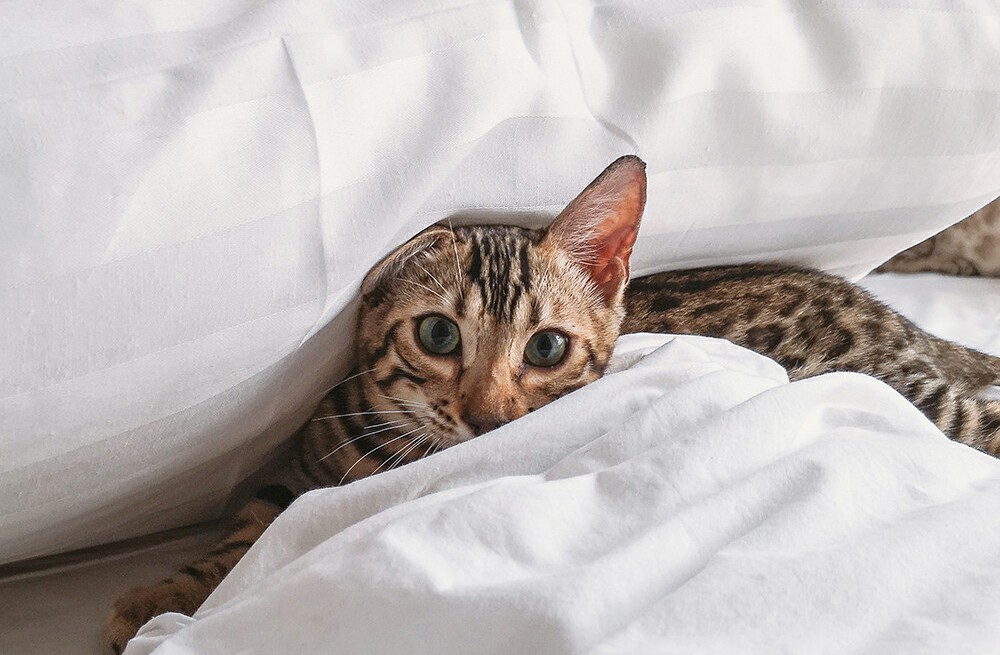
Now we’re all prepared, it’s time to fetch the victim.
Step 1: Keep a cool head
Cats can sense fear and anxiety. You need to be cool, calm and collected when talking to your Bengal. You should always be in control of the situation, especially when they try to escape.
If you’re having trouble holding them still, you can place them in a well-fitting harness. This will ensure your Bengal stays in the water safely without the need to grab them by the scruff.
If your Bengal is especially naughty, it will help to have more hands-on deck. One person can hold the kitty in place while the other one goes ahead with the bathing.
Don’t try to fight with your Bengal because you will most likely lose. If your Bengal is extra nervous, you may have to work your way up from getting a little wet to a full-blown bath.
Step 2: Shampoo time
You’ll want to start by getting your kitty wet from the neck down. You can use a blob of shampoo to wash your Bengals neck, body, belly, legs, and tail.
You should always move in the direction of their fur and massage in the shampoo like you would on your own head. Massage gently and slowly to avoid scaring your Bengal.
Shampoo no-no areas include the nose, ears, mouth, and eyes – basically, just try to avoid the head completely. Getting water and shampoo in your Bengal ears can increase the risk of ear infection (which is prone to Bengal cats already.)
If your Bengal has fleas, you’ll want to ensure the neck is wet first. This is because the fleas will flee to dry areas on the body, and if the neck is wet they can’t get to the face.
Step 3: Rinsing time
Once your Bengal is thoroughly soaped up, it’s time to wash off all the shampoo. You should be incredibly thorough about this since leftover shampoo will dry and cause skin problems.
This is where your freshwater bowl comes in handy, or if your Bengal can hack it, the showerhead. The water should be completely clear once you have finished rinsing.
TIP: If your Bengal has a long or thick coat, you can dilute the shampoo beforehand to make it easier to rinse (not recommended for flea shampoo.)
Step 4: Wash their face with a wash cloth
You don’t need shampoo for this, only clean water and a cloth. Gently wipe the fur around their eyes and nose. You can then wash the rest of the head and around their ears.
If your Bengal really does not want to do this, don’t push it. You can always do this at a later date and keeping them nice and relaxed is the main goal here.
Step 5: Drying time
Grab a few towels and begin drying your Bengal. To begin with, you’ll want to gently dab them with a dry towel. You can also warm the towels up beforehand to make it more comforting.
Once a good amount of the water has been removed, you can warp your Bengal burrito style. Gently run their fur and change towels once the first one becomes too wet.
If your Bengal isn’t liking the idea, stop and give them a break.
Once no more excess water is coming off your Bengal, you can let them air dry as long as they’re away from drafts. If you have a heated towel or a space heater, now would be a good time to bring them out.
Never ever leave your Bengal dripping wet.
If your Bengal has longer hair, it will take a lot longer to dry them. You’ll also need to thoroughly comb them to ensure no matting or knotting occurs.
If your Bengal isn’t scared of the hairdryer, you can finish drying them with that. The temp should be set to warm and you should always dry them at a distance.
Step 6: Reward them for their trouble
I’m mainly talking about you here! Grab yourself a glass of wine or a pint of ice cream and reward yourself for all your hard work.
Also giving your Bengal something tasty wouldn’t go amiss. Giving your Bengal positive associations with bath time will make next time much more manageable.
This could be their favorite treat, catnip, or wet food. If you have ultra special treats saved for special occasions, now would be a good time to crack them out.
If your Bengal enjoys petting over anything (let’s face it, most of them do) spend a good half hour giving them lots of pets and attention. They may be feeling a little vulnerable after the whole process, so some love will comfort them.
The dos and don’ts of bathing
When bathing your Bengal, there are a few things you should avoid at all costs and a few things you should always do.
Don’ts
- Never over-bathe your Bengal: If you’re washing them once a week, you’re doing too much. Just like for us humans, washing out hair too often only strips the natural oils and damages our hair further. Washing your Bengal more often than needed will only cause irritation.
- Never use human shampoo: You wouldn’t use cat shampoo on your hair, so why would you use human shampoo on your Bengal? The chemicals found in our shampoos are too strong and are not made for kitties. Using this kind of shampoo will result in irritation and skin infections.
- Don’t put their head underwater: Not only do cats detest getting their face wet, allowing water to enter their ears will cause infections.
- Never leave your Bengal wet: Always take your time in drying your Bengal. If they’re allowed to wander around dripping wet, they’ll only get sick.
- Don’t push them: If your Bengal is frightened, take a break. Terrifying them will only cause bath time to become even more of a struggle.
Dos
- Brush your Bengal: Even if your Bengal has short hair, it is always a good idea to give them a good brush before you begin bathing them. This will get rid of any knots they may have.
- Always thoroughly rinse: Ensure you remove all the bubbles from their coat so they don’t end up with any skin irritation.
- Make a secure environment: Bengal cats prefer small spaces as opposed to big ones. Washing them in a smaller room or a smaller tub may make them feel more at ease. A smaller room will also give them fewer opportunities to escape.
- Always reward them: Once bath time is over, give them some treats and lots and lots of love.
How do you brush a Bengal?
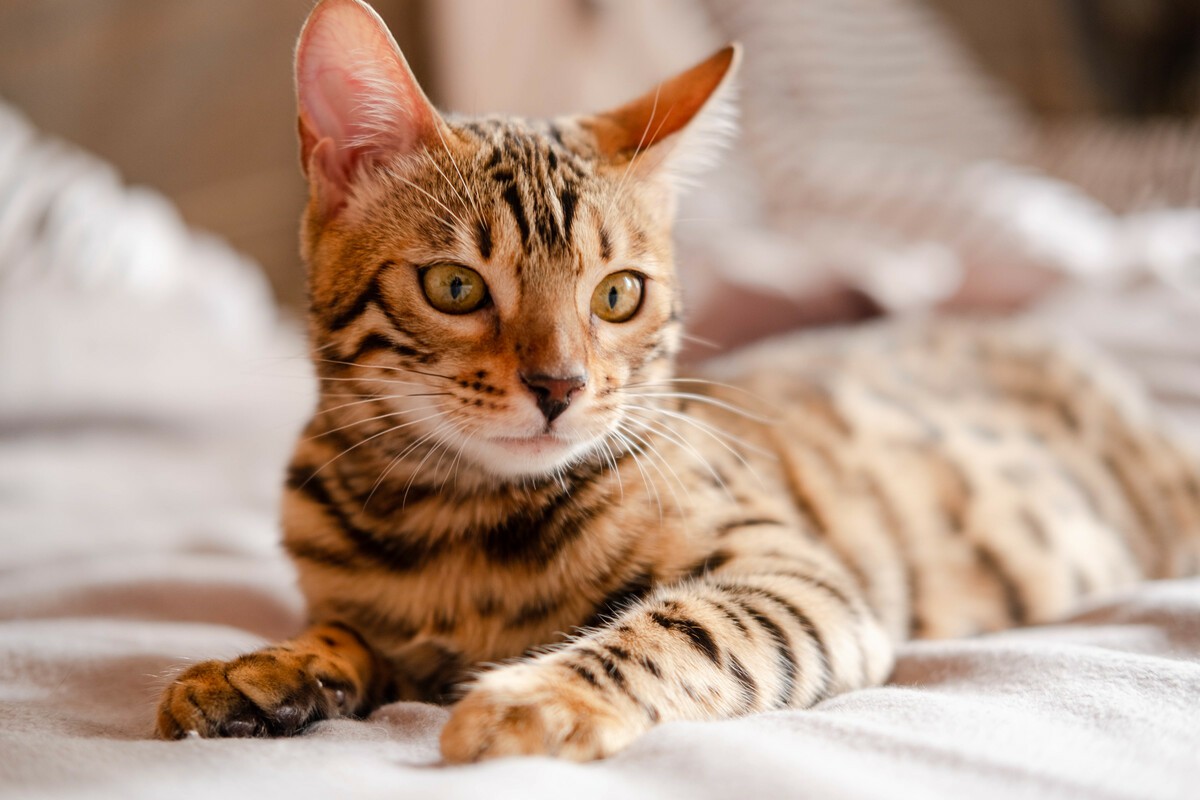
Typically, Bengal kitties love a good brush. It helps them feel relaxed and it’s not uncommon that they fall to sleep while you’re doing it.
When brushing a Bengal, you should always use a brush with soft bristles. These are great for removing knots and dander. It also avoids excessive pulling.
If your Bengal already has a few knots in their coat, I recommend using a wide-toothed comb. This will help loosen the knots before you go in with the soft bristle brush.
If the knots are too hard to remove, you’ll have to carefully cut them out to avoid any pain.
When it comes to brushing your Bengal, you should start at the neck and move down to the tail. Their fur should be brushed with the grain, and a couple of passes will be needed to remove all the loose hair.
Bruising against the grain does make it easier to remove loose hair, although it should be avoided as it can cause your Bengal pain.
When you move on to brushing their head and belly, you should always be extra gentle and take your time. These parts are the most sensitive on a cat. You may have an easier time if you switch to a smaller brush when combing the face.
If your Bengal has short hair, you’ll need to brush them once a week. If they have long hair, a few times a week will suffice.
How do you cut Bengals nails?
Before you bathe your Bengal, it is a good idea to “trim” their nails. We are putting the emphasis on the word trim because Bengal cats, or all cats in general, shouldn’t have their nails cut or declawed.
This should always be done when they’re in a good mood – mainly at night. Trimming the nails needs to be done very carefully as one slip can cause your Bengal a lot of pain.
Here are the steps you need to take:
- Make sure you have the correct nail clippers for a cat. You’ll be able to pick these up in almost any pet store or at a veterinary office. They need to be nice and sharp in order to cut them in one swift movement.
- Place your thumb on the top of their paw and your index finger on the paw pad. You can then gently push their paw to expose the nails. The pink part of the nails is called the ‘quick’ and should never, ever be cut.
- As you hold their paw, you should use your free hand to cut. Take your time and always make sure you double-check how much of the claw you need to cut.
- Once you have successfully cut the first claw, you can move onto the rest. Don’t be nervous or hesitant about it or your Bengal will sense that and become scared. It may take some getting used to, but you can do it!
- Use a nail file to gently smooth out the edges.
Or, if you love your furnitures yet don’t want to go through the hassle of trimming your Bengal’s nails, you can simply buy these Nail Caps for Cats for a safe, stylish and humane alternative to declawing! Just click the link to buy it from Amazon.
Can I bathe my Bengal and survive?
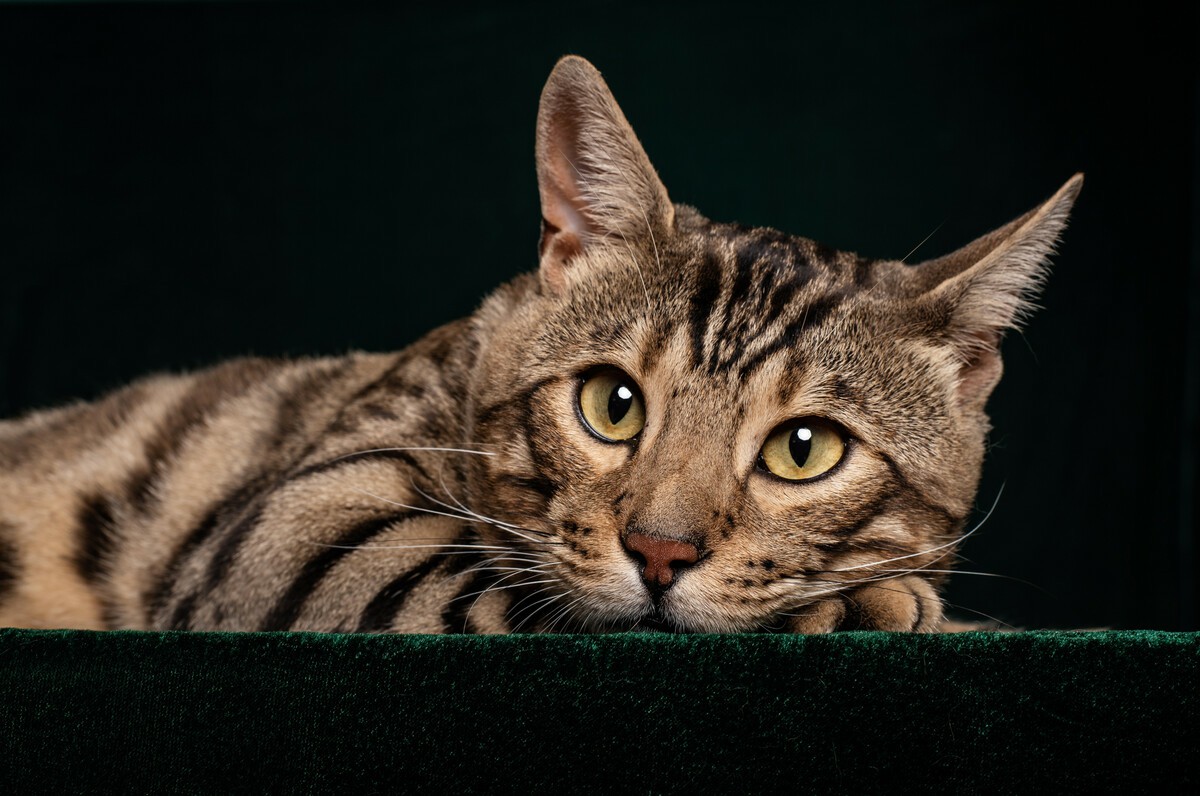
You sure can! With a bit of time and patience, bathing your Bengal can become an enjoyable experience for both of you.
You already have the upper hand in this situation since most Bengal cats aren’t afraid of water. If you can make a game out of it, they’ll maybe even enjoy bath time.
As long as you follow all the steps above and ensure your Bengal is always feeling safe, you have nothing to worry about.
Have you ever bathed your Bengal? If so, how did it go? Let us know your experience in the comments!

